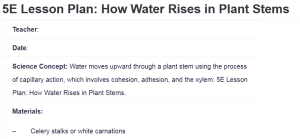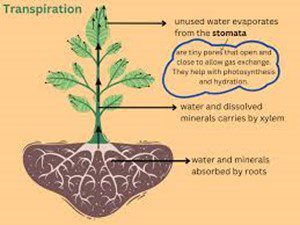5E Lesson Plan: How Water Rises in Plant Stems
| Teacher: |
| Date: |
| Science Concept: Water moves upward through a plant stem using the process of capillary action, which involves cohesion, adhesion, and the xylem: 5E Lesson Plan: How Water Rises in Plant Stems. |
| Materials:
– Celery stalks or white carnations – Clear cups or beakers – Water – Food coloring (various colors) – Magnifying glasses – Anchor chart paper |
| TEKS: 5.9(C) – Investigate and compare how plants and animals use structures and processes to survive. |
| Lesson Objective(s): The child will be able to explain how water rises in a plant stem through capillary action by completing a labeled diagram and answering guiding questions.
Vocabulary: 1. Capillary action 2. Cohesion 3. Adhesion 4. Xylem |
| ENGAGEMENT
1. Prior Knowledge: Plants need water to survive and have structures for water transport. 2. Fiction Book Title: “A Seed Is Sleepy” by Dianna Hutts Aston and Sylvia Long. 3. Activity: Read a passage from the book about how plants grow. Show pictures of flowers and plants to engage students. Sing a simple song about plant growth. 4. Scientific Method Question: “How does water move from the roots to the leaves in plants?”
|
| EXPLORATION
1. Scientific Method Poster:
2. Hypothesis: Students will predict that “Water can move up the plant.” 3. Materials and Procedure: Materials a. Celery stalk, water, cups, food coloring Procedure a. Fill the cup with water and add food coloring. b. Place the celery stalk in the cup. c. Observe over 24 hours. 4. Questions to Ask While Working: What color is the water turning in the stem? Why do you think the water is moving up the stem? What do you think would happen if we used a different liquid? 5. Documentation: Students will draw a picture of the celery or flower and label the parts where the color appears. 6. Results: Fill out the results section together on the scientific method chart. Discuss whether the results align with their hypothesis. |
| EXPLANATION
1. Student Explanation: Students share orally: “The water moved up the plant stem and changed the color. 2. Teacher Explanation (Anchor Chart):
Water moves upward in plants due to capillary action (Filipović, 2020). Cohesion keeps water molecules together, while adhesion helps them stick to the plant’s xylem (Bhatla & Lal, 2023). This allows the plant to transport water from the roots to the leaves. |
| ELABORATION
1. Activity Extension: Repeat the experiment with different liquids (salt water, sugar water) and compare the results 2. Creative Application: Have students write a simple poem about how water travels in plants. |
| EVALUATION
1. Graphic Organizer:
|
| Conclusion: Water movement through the plant stems happened because of capillary action and the cohesion and adhesion of water molecules in the plant’s xylem. |
References
Bhatla, S. C., & Lal, M. A. (2023). Concepts of plant water relations. In Plant Physiology, Development and Metabolism (pp. 3-23). Singapore: Springer Nature Singapore.
Filipović, A. (2020). Water plant and soil relation under stress situations. Soil moisture importance, 73.
ORDER A PLAGIARISM-FREE PAPER HERE
We’ll write everything from scratch
Question 
Assignment Details
< 24/FA EDTC 1374-7P1TeachingMath & Science in...
You will create a 5E Lesson plan based on the scientific method. For this mastery you do an experiment to fill out the lesson plan
template. The following are the files used for this assessment.

5E Lesson Plan: How Water Rises in Plant Stems
• 5E Lesson Plan
• Experiments for 5E Lesson
• Example of 5E Lesson Pic
You will turn in the completed scientific method for your experiment. You might have to create this yourself, because the explanation in the book does not really give you the steps in the procedure. ALL the parts must be filled out, including the conclusion. YOU MUST REALLY DO THE EXPERIMENT in order to fill this out.
• Pick your experiment from the list provided.
• You will use the 5E lesson plan template to complete this assignment. Sections in the template are to guide you as you complete the
lesson plan


